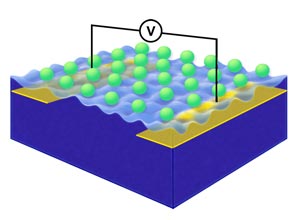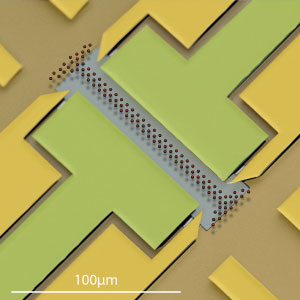Jul. 22, 2016 Research Highlight Physics / Astronomy
Friction-like effect observed in quantum system
Electrons moving across liquid helium exhibit spasmodic motion similar to that of rough surfaces being dragged across each other
 Figure 1: Electrons (green spheres) form a crystalline lattice when placed above liquid helium. By applying a voltage, researchers studied the motion of this lattice. © 2016 APS/Joan Tycko
Figure 1: Electrons (green spheres) form a crystalline lattice when placed above liquid helium. By applying a voltage, researchers studied the motion of this lattice. © 2016 APS/Joan Tycko
Applying a voltage to an array of electrons hovering above a sea of liquid helium (Fig. 1) causes the electron lattice to undergo ‘stick-slip’ motion resembling that between two sliding rough surfaces, an all-RIKEN team has discovered1.
Diamonds and table salt are common examples of crystals; they are three-dimensional arrays of periodically spaced atoms or ions. But electrons can also form crystals—when placed above a liquid helium surface, they arrange themselves into a flat crystal lattice. This crystalline arrangement arises as the electrons seek to maximize their distances from each other due to their mutual repulsion. In addition, a dimple forms on the helium surface immediately below each electron. This electron–helium system is ideal for exploring physical phenomena because it is free from defects that blight more complex systems.
When a rough solid surface is dragged across another surface it displays a kind of stop–start motion due to friction. This is because the pulling force has to build up until it exceeds the frictional force that resists motion. After the surface moves a short distance, the two surfaces become interlocked again until the pulling force increases sufficiently.
 Figure 2: Schematic depiction of array of electrons (brown dots) moving above liquid helium (gray area) due to the application of electric field. © 2016 Kimitoshi Kono, RIKEN Center for Emergent Matter Science
Figure 2: Schematic depiction of array of electrons (brown dots) moving above liquid helium (gray area) due to the application of electric field. © 2016 Kimitoshi Kono, RIKEN Center for Emergent Matter Science
A similar stick–slip motion has now been observed in an electron lattice above a liquid helium surface by Kimitoshi Kono of the RIKEN Center for Emergent Matter Science and his three RIKEN co-workers. By applying a voltage across a 100-micrometer-long channel with electrons floating above helium, they were able to drive the electron lattice across the channel (Fig. 2).
To their surprise, the researchers found that as they ramped up the voltage, the electron motion remained constant for a while, but accelerated dramatically when the electric field exceeded a critical value, before dropping back to its original level. “We did not expect to see this repeating process,” says Kono. “We were very excited when we first saw it.”
The motion of the electron crystal is restricted by the emission of ‘ripplons’—field quanta of capillary waves that form on the helium surface. These ripplons resemble the ripples produced by a moving boat. The electrons transfer momentum to the ripplons, and in so doing their own motion is slowed. At the critical electric field, the electron lattice overcomes a ‘sound barrier’ and all the ripplons are left behind, drastically reducing the lattice mobility.
The team is very excited about their discovery. “The present observation suggests the possibility of studying hydrodynamics on a nanoscale,” says Kono. “I believe that we have opened up a huge area of nanofluidics.”
Related contents
References
- 1. Rees, D. G., Beysengulov, N. R., Lin, J.-J. & Kono, K. Stick-slip motion of the Wigner solid on liquid helium.Physical Review Letters 116, 206801 (2016). doi: 10.1103/PhysRevLett.116.206801
